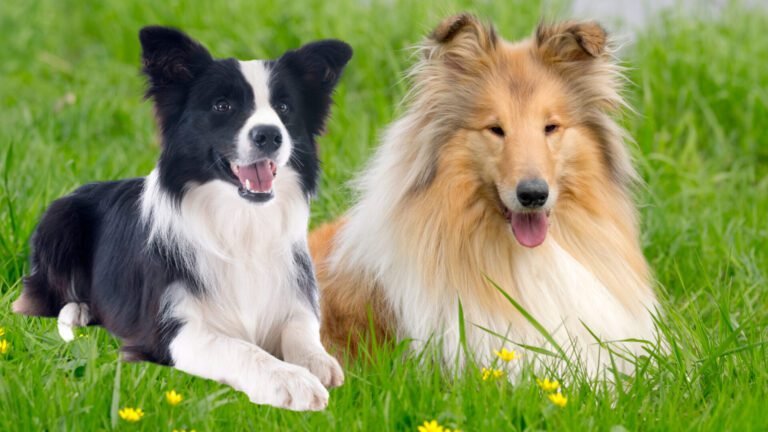Overcoming Border Collie Separation Anxiety: The Complete 12 Step Training Guide
Overcoming Border Collie Separation Anxiety: The Complete 12 Step Training Guide
Border Collies are notoriously prone to suffering separation distress and border collie separation anxiety when left alone. Their strong herding breed attachment to their owners causes many to panic in solitude. If your Border Collie displays frantic behaviors, destruction, or elimination issues when you step out, this guide provides a 12 step plan to curb separation anxiety.
Understanding the causes, implementing prevention tactics, desensitizing them to triggers, and rewarding calm independence are the keys to happier solo time for both you and your anxious Border Collie. With time and consistency,Separation anxiety in this sensitive breed can be overcome.
What Causes Border Collie Separation Anxiety?
Border Collies were selectively bred for generations as working sheepdogs meant to live in constant close proximity to their shepherd owner. This created a canine unusually attuned to people and one that feels most secure in their presence. When left alone, they feel panicked at the loss of their flock – their family.
Signs your Border Collie suffers true separation anxiety include:
- Panting, pacing, whining intensely right before or within minutes of you leaving.
- Destructiveness targeted at exit points like doors and windows.
- Inappropriate elimination only when left alone.
- Escaping to try and reunite with you.
- Barking and howling non-stop after you step out.
This anxiety emerges from the Border Collie’s inherent nature, not owner mistakes. But prevention tactics and training can improve independence. With time, patience and effort, your Border Collie can learn to relax while you are away.
Overcoming Border Collie Separation Anxiety Step 1: Properly Exercise Before Departures
Ensure your Border Collie gets adequate physical and mental exercise daily, but especially before separations. A long walk, play session, or training class helps them feel calm and relaxed when left later. Prevent boredom and restlessness that compounds anxiety.
Meeting their high exercise needs is always important. But a good romp right before you go provides the best separation buffer. A tired dog tends to fret less. And be sure to avoid intense exercise right before departing, as adrenaline worsens anxiety.
Overcoming Border Collie Separation Anxiety Step 2: Use Dog Appeasing Pheromone Products
Products like Adaptil diffusers and collars release pheromones mimicking nursing pheromones from mother dogs to soothe stressed pups. This calming scent helps many dogs relax. Use both the diffuser and collar together to reduce anxiety, especially during retraining.
While not a sole fix, pheromone products reduce the panic edge at key trigger times like your departure. They signal the dog to relax. Adaptil takes at least 1 week of continual use to reach full effect. But many owners report a notable decrease in signs of distress.
Overcoming Border Collie Separation Anxiety Step 3: Provide Mental Stimulation
In addition to physical exercise, mentally wear your Border Collie out before separations through training sessions, food puzzles, trick work, or chew toys. Combining brain and physical stimulation has the best anxiety-lowering effects.
Prevent boredom by providing activities that challenge their mind and satisfy their need to work. Food puzzles and stuffed chew toys keep them occupied after you leave. Intense exercise immediately before exit must be avoided, so mental play prevents restlessness.
Overcoming Border Collie Separation Anxiety Step 4: Establish Routine and Cues
Border Collies feel comforted by structure and routine. Establish regular daily departure and arrival times and use consistent cues like grabbing keys or saying “I’ll be back later!” Signals allow them time to process the situation logically rather than panic.
Equally important is keeping arrival greetings very low key. Avoid fanfare. Quietly taking them outside prevents anxious energy upon your return. Stick to a steady routine so your Border Collie learns your patterns and feels at ease predicting them.
Overcoming Border Collie Separation Anxiety Step 5: Provide a Secure Den
Offer a cozy den complete with well-worn clothing with your scent to retreat to when alone. Use a comfortable crate or small room where they feel sheltered but avoid full isolation. Positioning their space near the entry you exit from can also decrease anxiety.
The den should be enriching but not overstimulating. The goal is a quiet place of security, not distraction. Include safe chews but avoid high-value treats that excite. Support their natural denning instincts with their own safe cave full of comforting smells and associations.
Overcoming Border Collie Separation Anxiety Step 6: Try An Anxiety Wrap
These snug vests swaddle a dog in gentle, continual pressure thought to have calming effects similar to a cradle or hug. While not curative, wraps help take the edge off and may reduce destructive behavior. Fit them before departures and remove upon return. Check some out here
Wraps work best when paired with training, but provide a sense of security and warmth. Ensure proper size and allow your dog to adjust to wearing one while home before using at departure time. Supervise use and don’t leave on over 4 hours. An anxiety wrap reduces distress signals for many dogs if fitted properly.
Overcoming Border Collie Separation Anxiety Step 7: Ask for a Calm Sit Before Exiting
Require your Border Collie to demonstrate calmness by sitting politely before you step out the door. This forces composure and serves as a cue your exit is imminent. Opening the door becomes a reward only for a settled sit. Jumping or barking means you exit.
A brief obedience request focuses them prior to your departure. Maintain matter-of-fact energy – no reassuring pats or excess interaction. Use an upbeat release like “I’ll see you later alligator!” as you exit. The physical and mental task provides distraction.
Overcoming Border Collie Separation Anxiety Step 8: Desensitize Triggers
Border Collies stressed by your actions when leaving like grabbing keys or donning a coat can become desensitized through gradual exposure exercises. Perform these triggers calmly over and over without actually leaving to disassociate them from your exit.
For example, pick up/put down your keys 10 times in a row without leaving. Over many repetitions, the trigger becomes “boring” indicating you aren’t actually departing. The same applies for putting on/taking off your coat, shoes, and more. Reducing trigger sensitivity diminishes the panic response when you truly do step out.
Overcoming Border Collie Separation Anxiety Step 9: Crate Train for Calm Confinement
Using positive reinforcement, teach your Border Collie to feel secured and relaxed in their crate. This den-like space should be happy, but not stimulating. Provide special chews or toys only allowed when crated during your absence.
Start by just sitting nearby the crate praising and tossing treats for going inside. Slowly work up to latching the door while remaining home. Always reward calmness. Proper crate training creates positive associations so they see it as a calming retreat when you leave.
Overcoming Border Collie Separation Anxiety Step 10: Start Short Separations
Begin brief 2-5 minute departures while your Border Collie stays relaxed in their crate with a special chew. Use a security camera to observe from outside and return before anxiety escalates. Reward calmness.
Very slowly extend your absence duration week by week as long as anxiety remains minimal. If reactions are intense, go back a step for a while. Eventually work up to absences of an hour or two. Proper conditioning eases a Border Collie into accepting alone time.
Overcoming Border Collie Separation Anxiety Step 11: Provide Interactive Toys
Give your Border Collie a challenging food puzzle like a stuffed Kong or interactive toy to focus on just prior to your exit or while in their crate alone. The mental engagement from working to access the treats prevents boredom.
Choose non-messy chews and toys reserved for your departures only. The goal is occupying their quick mind with a task, not leaving a mess! Rotate puzzles to prevent boredom. Anything engrossing their intelligence provides distraction during the stresses of separation.
Overcoming Border Collie Separation Anxiety Step 12: Try Calming Supplements
Talk to your vet about anti-anxiety medication or natural calming supplements shown to take the edge off canine anxiety if needed. Used with training, these remedies help lower stress levels during the reconditioning process.
Some options may include medications like fluoxetine, clomipramine, or natural supplements like l-theanine, valerian root, chamomile, tryptophan, CBD oil, and more. Introduce any supplements gradually so your vet can evaluate effectiveness.
Frequently Asked Questions about Border Collie Separation Anxiety
Ready to tackle separation struggles with your Border Collie? Here are answers to some common questions about effectively addressing this common issue in the breed:
How long can I leave a Border Collie alone?
Adult Border Collies shouldn’t be left over 4-6 hours maximum. But work up very gradually to longer durations through desensitization training and providing mental stimulation. If over-panicked, some may only handle an hour or less initially. Patience and baby steps are key.
Is confinement cruel for a Border Collie with border collie separation anxiety?
When introduced positively using rewards for voluntarily entering and relaxing, a comfy crate actually provides a helpful sanctuary from stress. Through training, most Border Collies learn to view their crate as a safe den for rest and chew time. Ensure it’s enriching but not overstimulating.
Do Border Collies outgrow border collie separation anxiety?
With diligent counterconditioning and training, Border Collies can overcome separation distress and learn to relax alone as adults. But their tendency toward attachment means they may never enjoy solitude. Sticking to methods focused on rewarding calm independence yields the most progress over time.
Should I punish a Border Collie exhibiting anxious behaviors when left?
No, punishment or scolding is ineffective and only increases a Border Collie’s distress and confusion. Separation anxiety is driven by panic, not disobedience. Retraining focuses on preventing reactions through desensitization and teaching them to settle themselves through positive reinforcement.
What if my Border Collie injures himself during border collie separation anxiety?
If a Border Collie is harming themselves in a panic while you are gone, consult your vet about anti-anxiety medication and restrict access to potential dangers. Use crates, pens, or safe rooms. Medication can take the edge off while you work on conditioning them to tolerate being alone.
How can I get my Border Collie comfortable in a crate during separation?
Make the crate cozy and enriching with blankets and special chews. Use treats to reward voluntary crate entry and calmness inside. Very slowly work up to latching the door while home praising quiet behavior. Crate games build a positive mindset, so the crate becomes their secure den when you leave.
Overcoming Separation Anxiety Is a Process
Separation struggles in the people-focused Border Collie breed require counterconditioning over significant time to overcome. But implementing prevention tactics, desensitizing triggers, teaching relaxation skills, and preventing rehearsal of anxious behaviors allows progress.
With diligence and the right training approach focused on independence, it is possible to help your Border Collie learn to better tolerate reasonable alone time. Employ patience, proper confinement, calming aids, and rewards for calmness, and both you and your Border Collie will feel at ease during your comings and goings.








